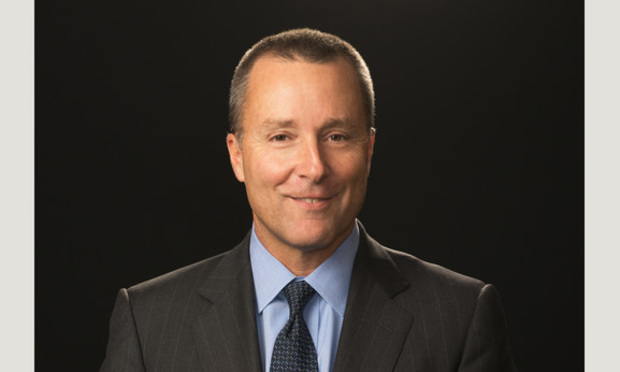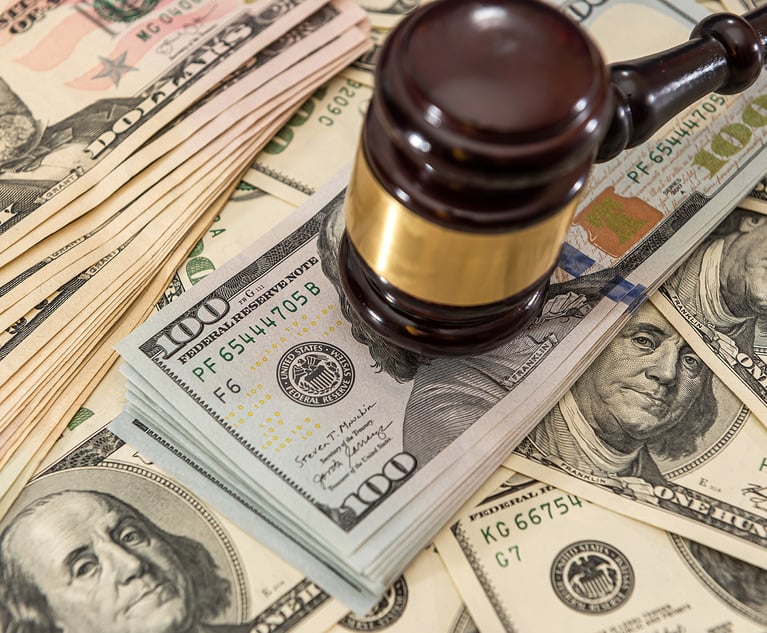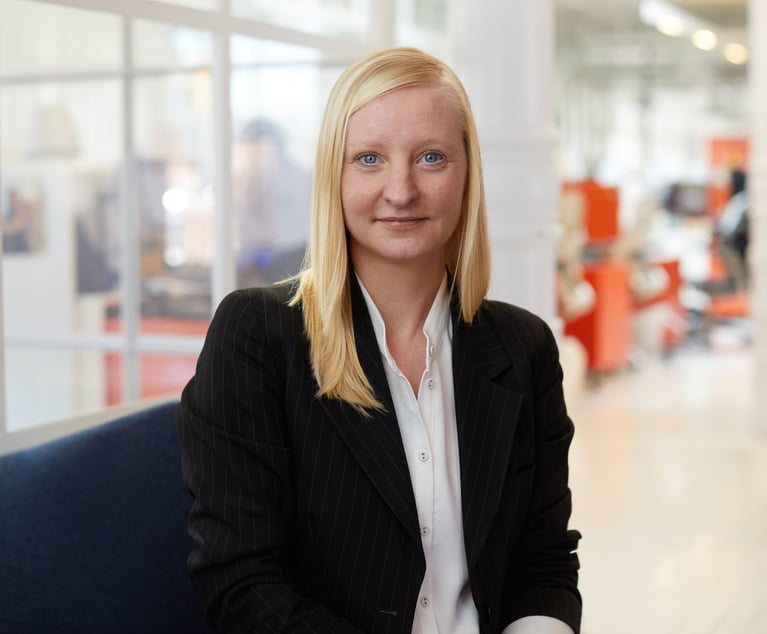Litigation Leaders: Cooley's Mike Attanasio on Strategy, Lateral Hires and Training New Trial Lawyers
Cooley's global litigation head Michael Attanasio shares his top three goals for 2019, what the firm looks for in lateral hires and what makes Cooley litigators unique.
February 25, 2019 at 04:19 PM
9 minute read
The original version of this story was published on Litigation Daily
 Cooley's Mike Attanasio.
Cooley's Mike Attanasio.
Welcome to the first in an occasional series featuring the lawyers who chair the AmLaw 200's premier litigation departments.
Cooley's Michael Attanasio is a member of the firm's management committee, serves as partner-in-charge of the San Diego office and heads the firm's global litigation practice, which in December 2017 won honorable mention in The American Lawyer's Litigation Department of the Year contest.
Lit Daily: Tell us a little about yourself—beyond what's in your law firm bio.
Mike Attanasio: Well, I spend too much time on airplanes, but our clients and my colleagues always seem to make it worthwhile.
In 1998, when I was a federal prosecutor with the [Justice Department's] public integrity section, I met my wife, Susan Lennon, during a high-profile public corruption trial in Houston. Susan was a reporter and anchor for NBC, assigned to cover the trial.
We dated “covertly” at the outset, culminating in a humorous exchange in which legendary Houston trial lawyer Rusty Hardin, who knew us both, approached me about setting us up on a first date. Too late. Susan ended up getting another reporter assigned, the jury returned guilty verdicts, and we married in 2000.
Twenty years later Susan still comes to my trials, including when Rusty and I reconnected for the successful trial defense of Roger Clemens.
I played Division I soccer for four years at Princeton, where I had the privilege to be coached by Bob Bradley, the future coach of the U.S. Men's National Team and the first American manager in the history of the British Premier League.
How big is your litigation department and where are most of your litigators concentrated geographically?
We have 380 lawyers in our litigation department, with fairly even concentrations across California and the East Coast, and a sizable group in London.
In what three areas of litigation do you have the deepest bench?
We have excellent depth and breadth across the department, largely because we stress a culture of courtroom advocacy as a unifying principle across all groups. At heart we are a diverse group of trial lawyers, backed by technical and industry specialization to meet our clients' needs.
We are incredibly strong in securities litigation and commercial litigation, including bet-the-company cases; intellectual property litigation for some of the most innovative life sciences and technology companies in the world; and cyber/data/privacy. We have been on the cutting edge of privacy issues for many global social media, technology, and gaming companies. It's a classic Cooley practice—we live where innovation meets the law—and one where we remain ahead of the curve.
As head of the department, what are some of your goals or priorities?
I have three significant priorities this year. First, we want to address the industry trend in which it is becoming ever more difficult for young lawyers to get meaningful experience “on their feet.” I worry that in 20 or 30 years, if not sooner, we will see a dearth of classically trained and experienced courtroom advocates among the biggest firms. There are a number of factors that have brought us here as an industry, but at Cooley we want our young lawyers to be mentored and trained as superior advocates first and foremost, and we are committed to getting them those opportunities at every turn.
Second, I want to build on the strides we have made on diversity and inclusion. It's an imperative for us, it's a fundamental priority for our clients, and our leadership team and our partners won't rest until we've succeeded.
Third, I want to leverage Cooley's momentum and brand to find and recruit the most talented litigators out there—from on-campus recruiting to lateral partner recruiting at the highest level. We're a talent business, and Cooley takes a back seat to nobody in recruiting the best talent in the market, especially next generation talent.
What do you see as hallmarks of your firm's litigators? What makes you different?
We constantly talk about the culture of courtroom advocacy that is instilled in every Cooley litigator beginning with our chairman, Steve Neal. From the moment we begin representing a litigation client, we not only assess the strengths and weaknesses of the case, but we begin to develop themes to tell our client's story. Every case, no matter how complex, is a story. If a lawyer can't distill that story into a crisp and cohesive narrative—the opening statement—then he or she needs to go back to the drawing board.
We think this way with full recognition that 99 percent of our cases won't go to trial, but also knowing that our clients benefit from our approach at all stages of a case—shaping discovery, taking depositions and preparing our witnesses for deposition, conducting settlement negotiations and drafting dispositive motions. At every stage we serve a client best when we tell its story with an eye to someday trying the case.
How many lateral litigation partners have you hired in the last 12 months? What do you look for in lateral hires?
We're thrilled to have brought on eight lateral litigation partners in the last year, and we expect to be similarly aggressive in the market this year.
Our standards are fairly simple—we want elite advocates who will fit into Cooley's culture of collaboration and teamwork. Over the last three years we've seen a significant increase in the submissions we receive from litigation candidates. We turn most of them away, but the tsunami of CVs and business plans suggests that Cooley's core strengths, especially our culture, are increasingly well known and attractive in the litigation market.
What were some of your firm's biggest in-court wins in the past year?
Last summer, a Cooley trial team prevailed after a two-week jury trial for client HyperBranch Medical Technology in a competitor patent litigation suit against industry behemoth Integra LifeSciences in the District of Delaware. Integra originally asserted 109 claims across six different patents and sought a preliminary injunction. After the Cooley team defeated the preliminary injunction, and secured partial wins on claim construction and summary judgment, the case went to trial. The jury found non-infringement across the board.
Cooley's securities litigators also showed their strength throughout the year, obtaining a string of dismissals and favorable appellate decisions for clients such as Horizon Pharma, GNC, Stratasys and Celladon in the Second, Third, Eighth, and Ninth Circuits, respectively, as well as other wins in the Delaware Court of Chancery, the Southern District of New York, and federal and state courts in California.
Underscoring its pro bono commitment, in October 2018 Cooley secured a significant victory in the latest chapter of the Saravia v. Sessions case, originally filed last year alongside the ACLU and Holly S. Cooper, co-director of the UC Davis Immigration Law Clinic. The Ninth Circuit affirmed a ruling that freed immigrant teenagers who were arrested and separated from their families based on unsubstantiated gang affiliation charges.
In a published opinion, the court upheld a preliminary injunction requiring the federal government to give the teenagers notice of the reasons for their arrests, access to the evidence being offered against them, and a prompt hearing in front of a judge, in which the government would have the burden to justify their detention. The litigation led directly to the release of several minors and reunification with their families.
Can you give an example or two of tactics you've employed that exemplify your firm's approach to litigating cases?
The watchwords are agility and measured aggressiveness. Our litigators know that sometimes we catch more flies with honey, sometimes less is more, and other times a heavier punch is required. One of our trials for Facebook illustrates the point.
In a jury trial brought by Rembrandt (represented by Fish & Richardson) against Facebook for patent infringement in the Eastern District of Virginia “rocket docket,” our lead trial lawyers (Heidi Keefe and Mike Rhodes) took tactical advantage of two key inflexion points. They obtained a complete win, with the jury finding no infringement and invalidating all patents in suit.
First, after our cross examination of Rembrandt 's key technical expert, during which crucial admissions were elicited, the team debated whether to call their own technical expert. They concluded that getting the case to the jury as fast as possible was essential, and so decided to stand on the cross and not call their own technical expert. They knew this would stymie Rembrandt's ability to try to rehabilitate its infringement theory via cross of Facebook's expert. This decision caught the other side by surprise and locked in the admissions that would pave the way for the verdict.
Second, during the cross of a critical Facebook witness, the court intervened and asked a key question about whether the accused technology performed one of the required claim limitations. Rembrandt moved for a mistrial on the ground that the court's examination was inherently prejudicial. During Rembrandt's closing argument, its counsel predicted that Facebook's lawyers would inevitably emphasize this piece of testimony. Cooley's team recognized that emphasizing the point wasn't necessary, and never mentioned the incident. On appeal, the Federal Circuit rejected Rembrandt's argument for a new trial on this precise point
The moral of the story? If all you have in the toolbox is a hammer, then every problem looks like a nail. Sometimes a different tool is required, and Cooley litigators have a well-stocked toolbox.
Where are you looking to build or expand in the next year?
Really everywhere, to be honest. We are looking opportunistically all the time, even within practices and geographies in which we are already very strong. One of our priorities in 2018 was to continue to build out our East Coast litigation teams, and we will certainly continue that this year.
Want to be featured in an upcoming Litigation Leaders profile? Email me at [email protected].
This content has been archived. It is available through our partners, LexisNexis® and Bloomberg Law.
To view this content, please continue to their sites.
Not a Lexis Subscriber?
Subscribe Now
Not a Bloomberg Law Subscriber?
Subscribe Now
NOT FOR REPRINT
© 2025 ALM Global, LLC, All Rights Reserved. Request academic re-use from www.copyright.com. All other uses, submit a request to [email protected]. For more information visit Asset & Logo Licensing.
You Might Like
View All
The Week in Data Jan. 21: A Look at Legal Industry Trends by the Numbers

The Right Amount?: Federal Judge Weighs $1.8M Attorney Fee Request with Strip Club's $15K Award

Avoiding the Great Gen AI Wrecking Ball: Ignore AI’s Transformative Power at Your Own Risk
6 minute readTrending Stories
- 1'Didn't Notice Patient Wasn't Breathing': $13.7M Verdict Against Anesthesiologists
- 2'Astronomical' Interest Rates: $1B Settlement to Resolve Allegations of 'Predatory' Lending Cancels $534M in Small-Business Debts
- 3Senator Plans to Reintroduce Bill to Split 9th Circuit
- 4Law Firms Converge to Defend HIPAA Regulation
- 5Judge Denies Retrial Bid by Ex-U.S. Sen. Menendez Over Evidentiary Error
Who Got The Work
J. Brugh Lower of Gibbons has entered an appearance for industrial equipment supplier Devco Corporation in a pending trademark infringement lawsuit. The suit, accusing the defendant of selling knock-off Graco products, was filed Dec. 18 in New Jersey District Court by Rivkin Radler on behalf of Graco Inc. and Graco Minnesota. The case, assigned to U.S. District Judge Zahid N. Quraishi, is 3:24-cv-11294, Graco Inc. et al v. Devco Corporation.
Who Got The Work
Rebecca Maller-Stein and Kent A. Yalowitz of Arnold & Porter Kaye Scholer have entered their appearances for Hanaco Venture Capital and its executives, Lior Prosor and David Frankel, in a pending securities lawsuit. The action, filed on Dec. 24 in New York Southern District Court by Zell, Aron & Co. on behalf of Goldeneye Advisors, accuses the defendants of negligently and fraudulently managing the plaintiff's $1 million investment. The case, assigned to U.S. District Judge Vernon S. Broderick, is 1:24-cv-09918, Goldeneye Advisors, LLC v. Hanaco Venture Capital, Ltd. et al.
Who Got The Work
Attorneys from A&O Shearman has stepped in as defense counsel for Toronto-Dominion Bank and other defendants in a pending securities class action. The suit, filed Dec. 11 in New York Southern District Court by Bleichmar Fonti & Auld, accuses the defendants of concealing the bank's 'pervasive' deficiencies in regards to its compliance with the Bank Secrecy Act and the quality of its anti-money laundering controls. The case, assigned to U.S. District Judge Arun Subramanian, is 1:24-cv-09445, Gonzalez v. The Toronto-Dominion Bank et al.
Who Got The Work
Crown Castle International, a Pennsylvania company providing shared communications infrastructure, has turned to Luke D. Wolf of Gordon Rees Scully Mansukhani to fend off a pending breach-of-contract lawsuit. The court action, filed Nov. 25 in Michigan Eastern District Court by Hooper Hathaway PC on behalf of The Town Residences LLC, accuses Crown Castle of failing to transfer approximately $30,000 in utility payments from T-Mobile in breach of a roof-top lease and assignment agreement. The case, assigned to U.S. District Judge Susan K. Declercq, is 2:24-cv-13131, The Town Residences LLC v. T-Mobile US, Inc. et al.
Who Got The Work
Wilfred P. Coronato and Daniel M. Schwartz of McCarter & English have stepped in as defense counsel to Electrolux Home Products Inc. in a pending product liability lawsuit. The court action, filed Nov. 26 in New York Eastern District Court by Poulos Lopiccolo PC and Nagel Rice LLP on behalf of David Stern, alleges that the defendant's refrigerators’ drawers and shelving repeatedly break and fall apart within months after purchase. The case, assigned to U.S. District Judge Joan M. Azrack, is 2:24-cv-08204, Stern v. Electrolux Home Products, Inc.
Featured Firms
Law Offices of Gary Martin Hays & Associates, P.C.
(470) 294-1674
Law Offices of Mark E. Salomone
(857) 444-6468
Smith & Hassler
(713) 739-1250









